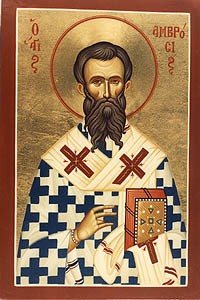Holiday: December 7th
* around 339 Trier, Rhineland-Palatinate, Germany
† April 4 (?) 397 Milan, Italy
Attributes: hive, book, whip, bone, pen
Patron saint of merchants, beekeepers, bakers, students.

St. Ambrose, a Russian icon
St. Ambrose is one of the four great Western teachers of the Church, along with Augustine, Jerome, and Gregory the Great. He was born around 339 in Trier (now southwestern Germany). When his father died in 350, his mother and two sons went to Rome. Ambrose’s sister Marcelino was already in a monastery there. Ambrose was very talented, and his mother chose the best teachers of the time for him. He gained a perfect understanding of art, rhetoric, and law. After his studies, he became a lawyer. He gained admiration for his education, eloquence, justice, and love. Thanks to his friend Anicius Probus, the governor of Italy, he became a judge in the highest state offices. In 373, he became governor of Milan, Piedmont, Genoa, and Bologna. He held his office with all kindness and amiability, for which he soon gained general popularity.
When the Arian bishop Auxencius died in Milan in 374, unrest arose over the election of a new bishop. The Arians wanted a bishop from among themselves, and the Catholics wanted an orthodox one. There was fear that a rebellion and murder would break out. The imperial governor Ambrose rushed to the temple to calm the unrest. In the temple, he delivered a fiery speech, admonishing both sides. Everything fell silent. Suddenly, a child in the temple exclaimed: “Let Ambrose be bishop!” Other Catholics and Arians, now united, joined in. Ambrose objected to the fact that he had no theological education and was not even baptized. He even had two women of dubious reputation brought to his palace and two criminals strung up on a pole to make it appear that he had an evil heart and was not worthy of the episcopal rank. When that didn’t work either, he fled. However, they found him the very next day. They sent a message to the emperor asking him to permit them to make Ambrose a bishop. The emperor agreed. After careful preparation, the priest Simplicity baptized him on November 30, 374. He was subsequently ordained a priest and consecrated a bishop on December 7.
Ambrose fearlessly defended the Church and fought against heretics and worldly attacks. He distributed all his movable property to the poor and donated his immovable property to the Church. He entrusted the administration of these properties to his brother Satyr so that he could devote himself solely to the episcopal service. Furthermore, he lived modestly, fasted, and did not go to feasts. He studied diligently, which he lacked. The priest Simplicity further guided him. He preached every Sunday. Augustine also began to attend his sermons, whom Ambrose later baptized.
His zeal is also evidenced by the fact that he did not even allow Emperor Theodosius to enter the temple when he sinned by killing thousands of innocent people. He stood in his way and publicly excommunicated him from the Church. Only after eight months of public repentance did he lift the excommunication from the emperor and grant him absolution. He continued to work vigorously. Towards the end of his life, he also devoted himself to writing religious books. He died on Holy Saturday, April 6, 397. He left behind several writings, letters, speeches, and hymns. Likewise, he also contributed significantly to liturgical singing in Milan. The name “missa” – mass for the Eucharistic celebration – comes from him. In 1295, Pope Boniface VIII. Granted him the title of Doctor of the Church. His feast day is celebrated in the Church on the day of his episcopal ordination – December 7.